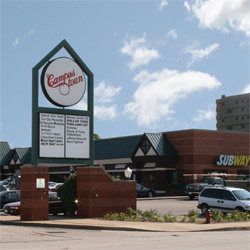
TIF districts seem to be in the news on a daily basis, yet very seldom do you get the full story of how a TIF works and what benefits a city derives from it. Perhaps this is because TIFs can be rather complicated, but they are an important weapon in a city’s arsenal for fighting urban decay and are well worth understanding.
A TIF (Tax Increment Financing) district is an area within a city that, after much careful study by the city and expert consultants, is found to be “blighted” and without hope of attracting private investment without some governmental intervention. These are important criteria that must be met prior to the creation of a TIF, and they ensure that the funds generated from a TIF are used in areas truly in need of redevelopment. A city is not free to slap the TIF label on any property it wants, and what constitutes “blight” is specifically defined in the TIF statute. If an area does not meet the definition of blight under the statute, the city will not be able to create a TIF there.
So once a city identifies a part of town that meets the criteria and would benefit from a TIF, how does it work? A TIF district essentially reallocates funds from property taxes to encourage investment within the district. An important thing for property owners within the TIF to understand is that their property tax rates do not automatically go up with the creation of a TIF.
The way TIFs shift funds around to encourage development is by freezing the allocations to various taxing bodies (e.g. park districts, etc.) at their levels as of the start of the TIF. For the life of the TIF (typically a maximum of 23 years), the amount received by these taxing bodies from property taxes collected within the TIF will remain constant, unless the city decides to redirect TIF funds back to one or more taxing bodies because of an increased need for that body’s services, which is not uncommon. Any increased tax revenues collected as a result of an increase in property values then go into the TIF fund and can be used by the city for a wide range of purposes within the TIF to promote redevelopment.
Here is an example of a hypothetical TIF to demonstrate how the process works: A city decides that an area is in horrible condition, with no hope of being restored unless the government steps in. The expert consultants agree, and the area meets the criteria for a TIF district under Illinois law, so a TIF is created. Property tax rates are not affected by the TIF. At the beginning of the TIF, the aggregate property value of all land in the TIF is $1,000,000, and annual property tax revenue is $40,000. This $40,000 is split between a handful of taxing bodies. After the TIF is created, the taxing bodies know that they will continue to receive $40,000 per year for the life of the TIF.
Perhaps after a couple years, property values within the TIF increase to $1,100,000, which leads to annual tax revenues of $44,000. This extra $4,000, instead of being distributed to the taxing bodies, is deposited in the TIF fund for the city to use to reinvest in the TIF area. As the city invests in the area and private investors begin to be attracted by the city’s efforts to revitalize the community, a snowball effect occurs. More TIF investments by the city lead to more investments by private developers, both of which lead to higher property values, and therefore, more TIF revenue that can be reinvested in the TIF district, starting the cycle all over again.
And just what types of investments can a city make with those TIF funds? The Illinois TIF law contains a list of very specific purposes for which TIF funds may be used, and contrary to some accusations, “kickbacks to developers” is not one of them! Permissible uses for TIF funds include, among others, infrastructure improvements (e.g. roads, utilities), job skills training for workers within the TIF, marketing the area to prospective new businesses, and building new public buildings.
As for the taxing bodies within the district, while their revenues are frozen with regard to properties within the TIF, it’s not unusual for them to see increased revenues overall because TIFs often have spillover effects that cause property values to rise in the areas surrounding them, which benefits the taxing bodies. Additionally, if the redevelopment plan for the TIF district will create increased capital costs for any taxing body within the TIF, the city may agree to use TIF funds to pay for such costs. Once the period of the TIF expires, the taxing bodies are entitled to their full share of the tax revenue from within the TIF.
Clearly, TIF districts are powerful tools available to a city that can often be complicated and are occasionally misunderstood. When used properly, however, a TIF can revitalize a community. In the City of Peoria, for example, according to data obtained from its website, the vast majority of TIF districts have seen growth much greater than that of the rest of the city.
So why should you care about TIF districts? If you care about your city and its run-down areas, you should know that your government has a tool at its disposal to help fight urban decay that’s been proven to be successful right here in our own backyard. iBi

